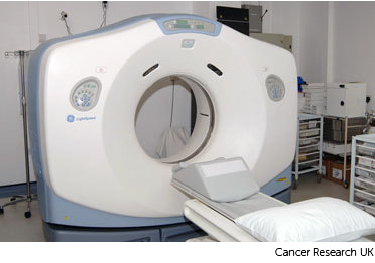Planning radiotherapy for rectal cancer
The radiotherapy team plan your external radiotherapy before you start treatment. This means working out the dose of radiotherapy you need and exactly where you need it.
Your planning appointment takes from 15 minutes to 2 hours.
You usually have a planning CT scan in the radiotherapy department.
The scan shows the cancer and the area around it. You might have other types of scans or x-rays to help your treatment team plan your radiotherapy. The plan they create is just for you.

Before the scan
You usually get a bowel and bladder prep sheet a few weeks before your scan. This explains how you can help prepare your bladder and bowels for the planning scan and treatment. Following this advice can help reduce long term side effects to your bladder and bowels.
Your radiographer will explain how to prep your bladder and bowels. They will check you have emptied your bowels that day and ask you to empty your bladder. They will then explain how you can fill your bladder by drinking water. You will have to also do this before every treatment.
If your bladder is not full enough, or your bowels aren't empty enough, the scan may need to be repeated.
Your radiographers then tell you what is going to happen. They help you into position on the scan couch. You might have a type of firm cushion called a vacbag to help you keep still.
The CT scanner couch is the same type of bed that you lie on for your treatment sessions. You need to lie very still. Tell your radiographers if you aren't comfortable.
During the scan
Once you're in position the radiographers put some markers on your skin. They move the couch up and through the scanner. They then leave the room and the scan starts.
The scan takes about 5 minutes. You won't feel anything. The radiographers can see you from the CT control area where they operate the scanner.
Injection of dye
You might need an injection of contrast into a vein in your hand. This is a dye that helps body tissues show up more clearly on the scan.
Before you have the contrast medium, the radiographer asks you about any medical conditions or allergies. Some people are allergic to the dye.
Your treatment team can put all the scans together in a special computer to decide your radiotherapy plan.
Ink and tattoo marks
The radiographers make pin point sized tattoo marks on your skin. They use these marks to line you up into the same position every day. The tattoos make sure they treat exactly the same area for all of your treatments. They may also draw marks around the tattoos with a permanent ink pen, so that they are clear to see when the lights are low.

The radiotherapy staff tell you how to look after the markings. The pen marks might start to rub off in time, but the tattoos won’t. Tell your radiographer if that happens. Don't try to redraw them yourself.
After your planning session
You might have to wait a few days or up to 3 weeks before you start treatment.
During this time the physicists and your radiotherapy doctor (clinical oncologist) decide the final details of your radiotherapy plan. They make sure that the area of the cancer will receive a high dose and nearby areas receive a low dose. This reduces the side effects you might get during and after treatment.



